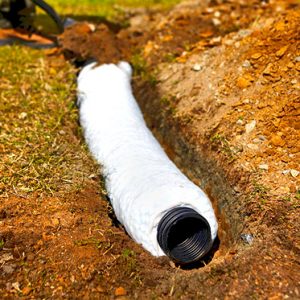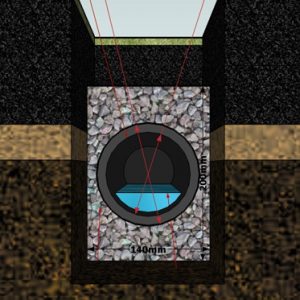As much as we may need water, it sure can cause us a lot of problems. This is especially true when it comes to the structures that we build and the management of land. Over the centuries, humans have invented ways to move water. We want to get it where we need it, and away from where we don’t.
One of the most common ways to protect a property against water damage is the use of a French drain. As a drain & plumbing contractor
we have years of experience. We’ve installed many Below-ground drainage. A Gravel drain system, or weeping tile, is a versatile drainage system. It’s used in many situations. This post will explore Basement water drainage. We’ll cover their maintenance, how they work, and their benefits to some properties.
.
What is a French drain?

A Laying a drainpipe is being installed at a home in Toronto.
As you may have guessed, a French drain is a type of drainage system. Most Subsurface drainage are for managing surface and groundwater. Most Laying a drainpipe aim to move water away from a structure. They should direct it to a safe place where it won’t cause harm.
You may have seen a Soggy lawn solution before. It looks like someone filled a trench with gravel. Under the gravel, there is usually a perforated drainage pipe. You can see the pipe’s end at the discharge end of the French drain.
The terms “French drain” and “weeping tile” are frequently used interchangeably. While this is usually acceptable, there are some slight differences between the two. A Laying a drainpipe is usually installed just below the surface. Its main purpose is to prevent soil from becoming too saturated. A weeping tile is a type of Water drainage solution. It protects a structure from hydrostatic pressure. The pipe is usually much deeper in the ground. It is often used to protect a structure’s foundation.
If you are using the terms interchangeably or hear someone else do so, it is not a significant issue. It is now accepted that they both mean the same type of drainage system. People will know what you are talking about either way.
How does a French drain work?
Whether you are talking about a French drain or a weeping tile system, the drain will work under the same principles. Gravity will always cause water to flow downhill. Water will flow along the path of least resistance. The operation of a Surface water removal relies on these facts of nature to manage the moisture in the soil.
A piece of perforated pipe makes a French drain. It is laid in a trench and surrounded by gravel. The gravel or stone in a French drain has several functions. Its main purpose is to be more permeable than the surrounding soil. This gravel, known as the “envelope,” helps water flow easily. Its high permeability draws moisture from the nearby soil. It guides the water into the trench as the easiest path.

Workers bury a French drain underground to collect groundwater.
French drains have been around for a long time. A modern Curtain drain will likely have landscaping fabric over the gravel. This fabric will stop weeds and reduce sediment runoff into the trench. This will help prevent clogging of the Curtain drain.
Contractors might also use different types of pipe in the construction of a French drain. Some might use PVC with pre-drilled holes. Others use a flexible drainpipe with small slits on the side. The choice between the two can depend on the exact application, but PVC tends to be more durable. You can also find a pipe that encases a type of landscaping fabric.
A French drain must have a slope. It should descend away from the area where you want to remove moisture. This slope is where gravity comes in. The trench and pipe slope will make the water run downhill to a discharge point. The gravel makes the trench the path of least resistance for the water. The grade takes advantage of gravity, making the water flow as intended.
The discharge point of a drainage pipe setup will depend on the application for which it is being used. You want to direct the water away from what you want to protect. However, laws and codes may prevent you from discharging it in certain places.
For a weeping tile system, the pipe often discharges into a sump pump pit in the basement. Some French drains might discharge into a local storm sewer. Others might discharge at a different spot on the property. Avoid a discharge point that will cause water to flow onto a nearby property. It is almost always important to do this.
When is a French Drain Needed?
Outdoor water management are great. They can fix many ground and surface water issues on a property. For the purposes of this post, we are going to stick to some of the more common uses of French drains.
Protect against wet basements and foundation damage
A French drain, or weeping tile, is a great way to keep water out of a basement. It also protects a foundation from water that may penetrate the concrete.
Saturated soil can exert hydrostatic pressure on a home’s foundation. This can cause water to seep into the foundation, and it can allow that water to get into the basement. Also, hydrostatic pressure and seepage can damage the foundation. A weeping tile system can relieve hydrostatic pressure. This should prevent these problems.
Problems with surface water
Surface water can cause all sorts of problems for a property. You might have a low area of your lawn that pools with water. It may be soggy. You might also have some soil erosion in places.
In these cases, a shallow French drain can help. It can direct water away and prevent pooling and soil erosion. Sometimes, contractors might install the French drain near the area to drain water. In other cases, it can divert water running downhill into a low-lying area.
Protection for retaining walls
A retaining wall can increase the usable land on a property, and it can also prevent erosion. The retaining wall should hold back the soil. But you must protect it against the pressure if the soil becomes waterlogged. To do this, you will need some type of toe drain for the wall.
With most retaining walls, the toe drain will follow the same design as a Trench drain system. As water runs downhill toward the wall, it can put an immense amount of pressure on a retaining wall. This could compromise the integrity of the structure. In this case, you would build a French drain behind the wall near the footing.
How deep do you dig a French Drain?
The depth of a French drain is going to depend on a variety of factors. The key factor in deciding the depth is the drain’s use. One important point to remember is that a French drain must slope down to the discharge point. So, it should get shallower as you go toward it.
If you are talking about a weeping tile system, the French drain should start below the footing. A French drain that protects a retaining wall has the same purpose. To manage surface water problems, you can adjust the depth a bit. The general recommendation is 18 inches to 2 feet.
How much does it cost to install a French Drain?
Like any construction project, the cost of installing a French drain will vary. It will depend on many different factors. The drain’s use, length, and depth can affect the cost. Also, soil conditions might play a role. You must consider the materials used.
Considering all these factors, the cost can vary significantly. If you are pricing by the foot, it could run you anywhere from $12 per linear foot to $40 per linear foot. For average completion costs, $1,000 is a good minimum. But for larger jobs, it could run to several thousand dollars.
How do you Unclog a French drain?
As with any drain, a French drain does have the possibility of getting clogged. Sediment and other types of debris can build up in the line, and this can cause the water to back up. You can also find problems where a tree root grows into the line to form an obstruction. This can cause the water to back up and flood the area you want to protect.
Install a French drain with cleanouts. These are points that provide access to the pipe and allow you to clear any clogs. You should have one at the highest point of the French drain. You may need others, depending on their length and elevation changes.
Once you can access a cleanout point for the French drain, you can clean it like any other drain. You can use a drain snake to clear a French drain, or you can use water jetting to clear the line.
If you are having problems with your French drain, it might help to hire a professional. Some of these clogs can be very tough to clear, and in some cases, there is a risk of damaging the pipe. A pro will know how to clear the line and prevent damage. They might even use a drain camera to check for damage.
As an additional point, some problems can occur when a section of the line collapses. This is likely to result in the system backing up, and it will require drain repairs. If you find that your French drain is clogged and you can’t get it clear, this could be an indication of a collapsed line.
A French drain can be the best fix for issues with groundwater and surface water. A good French drain can protect the foundation of your home, and it can also protect the value of your property. If you need a French drain installed, you must do the work right. If it is installed incorrectly, it won’t function at all. It could cost you more in repairs, replacements, and water damage.







The most critical item for french or trench drain is the quality of gravel and perforated pipe. Never compromise on quality of these items and this will last for ages. Weeping tiles prevent surface water to damage building. My house initially didn’t have it, but upon recommendation of my plumber we did it a couple of years ago. Now, the foundations of my house are safe.
I think french drain gets clogged only when we don’t do proper cleaning after a certain time. Those who don’t pay attention to proper cleaning of French drain may face a nasty situation of clogged French drain. If you care about the foundation of your house, never overlook cleaning of French drain.
With my own experience, I recommend French drain to every property which has water drainage problems. Since I installed this drainage system, I got rid of excess water from my home. It is safe and works great for most of the drainage issues.